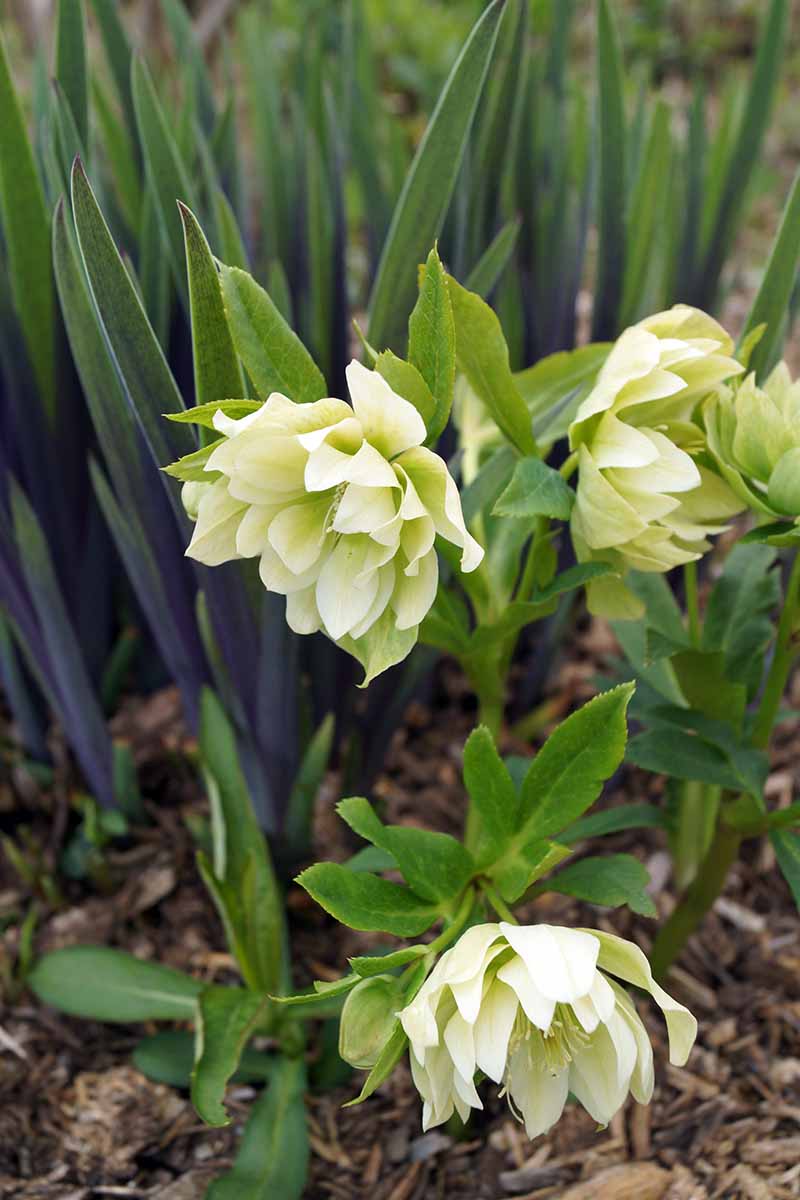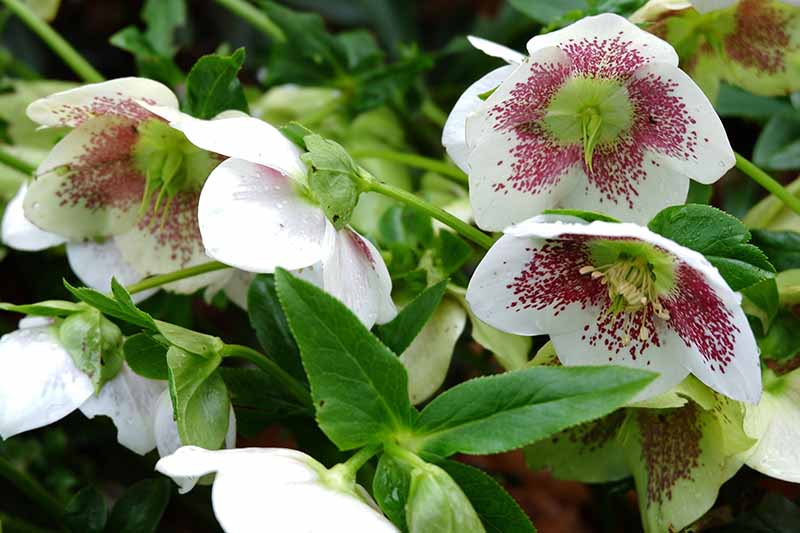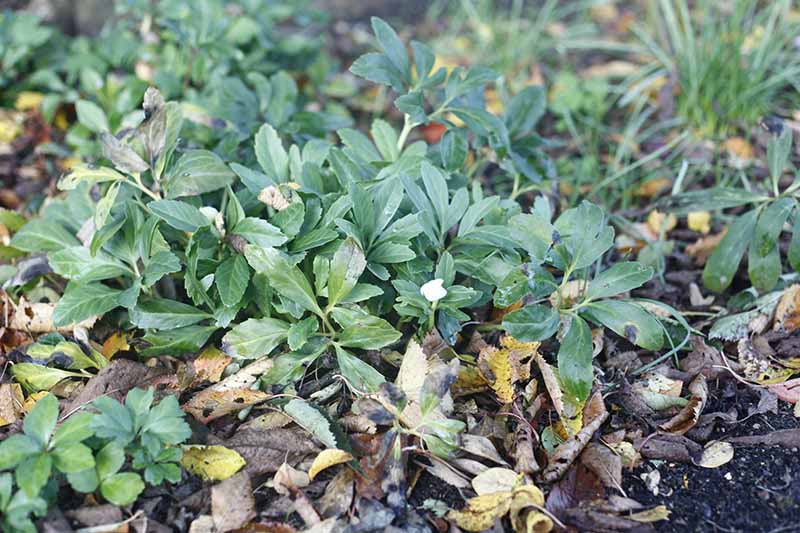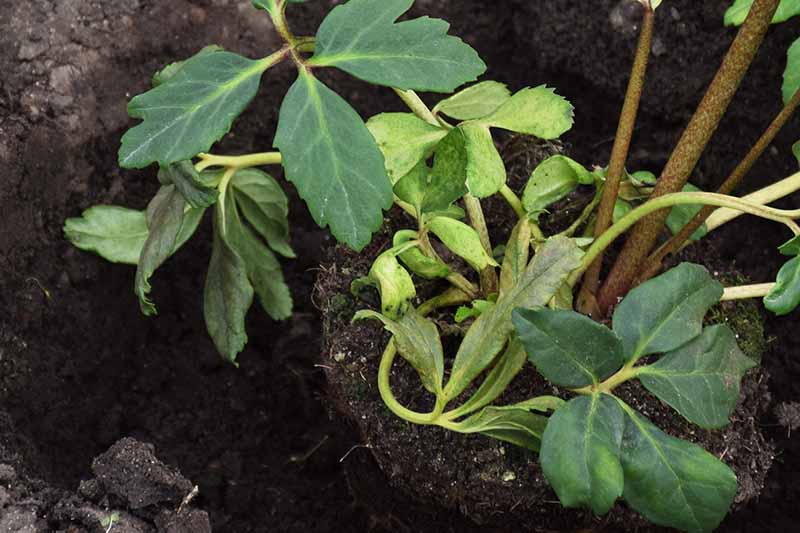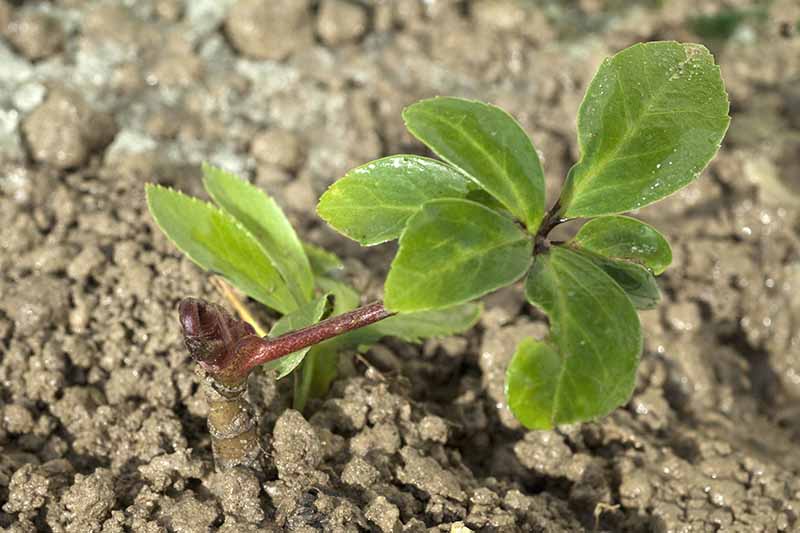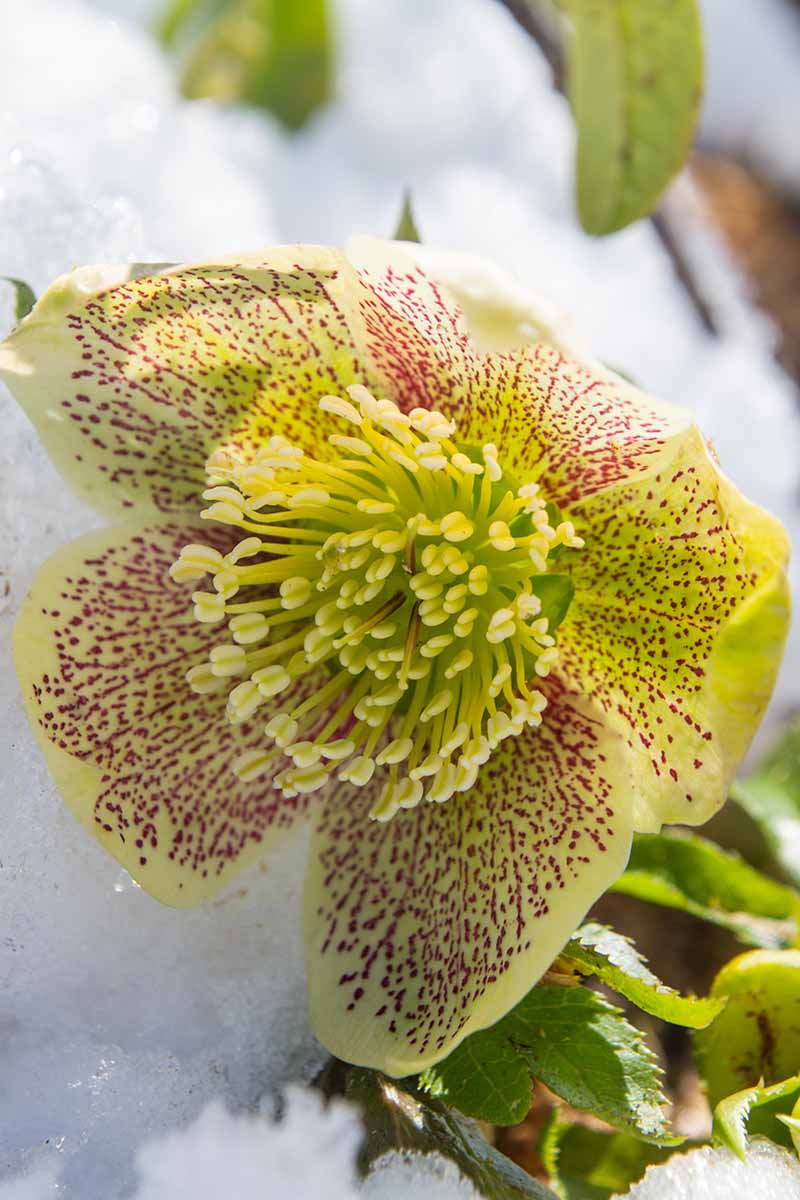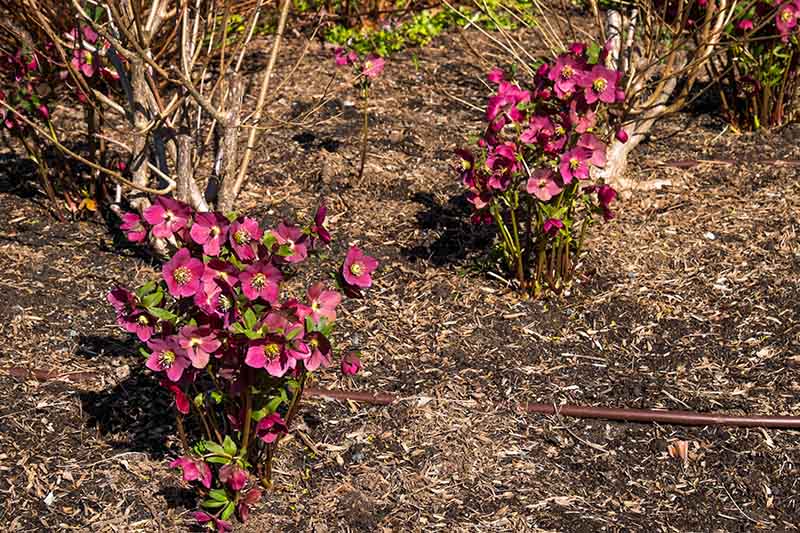The most common types available to the home gardener are of the Helleborus orientalis species, aka Lenten rose, as well as hybrids of this species and a few other distinct species. The hybrids are classified generically as H. orientalis x hybridus. This species and its hybrids – members of the Ranunculaceae family – are acaulescent, which means that they have abundant foliage at the base, and flower stems that rise individually from the thick root, or rhizome, below. We link to vendors to help you find relevant products. If you buy from one of our links, we may earn a commission. In this article, you will learn how to divide an acaulescent hellebore and transplant the divisions. If you’re new to growing hellebores, see our full growing guide here.
Why Propagate by Division?
Division creates a true replica, or clone, of the original plant. Propagation by division preserves the exceptional traits like double rows of sepals, foliage variegation, speckling, and unusual color of the parent plant.
There are two additional ways to propagate hellebores:
- Planting Seed
- Micropropagation Seed from some types of plants produce “true” to the parent. But for cultivated hellebores, it may yield one or a number of different colors that may or may not resemble the parent plant. Learn more about harvesting hellebore seeds for propagation here.
Micropropagation involves the extraction of plant tissue for propagation in a laboratory setting. When you want to be certain that a hellebore you propagate will have the traits you desire, it must be divided from a plant known to have those characteristics.
Choosing the Right Time
Plants do their hardest work when they bloom and set seed. At these times, leave them alone to do their job. Dividing is best done either before blooming or after the plant has set seed. There are two ideal windows of opportunity for this task:
Late winter Early fall
Let’s consider both options, as well as the pros and cons of each.
Late Winter
In late winter, at just about the time when you’re fed up with the ice and snow, look for the first new hellebore shoots. If you’re like me, and you leave the old foliage in place until spring, their locations should not be hard to find. On the other hand, if you cut your plants to the ground last fall, hopefully you remembered to mark their locations. Otherwise, if there’s snow on the ground, you may not notice the new growth until the flowers show their heads. Either way, to divide before flowering, you will need to locate your plants and take action before the buds set. Pros:
Transplants have ample time to become established before winter comes around again.
Cons:
A late frost could damage or kill transplants. Fragile new shoots may be damaged during the division process. Locating new shoots before they bud may pose a challenge.
Early Fall
After perennials have flowered and gone to seed, they’re fair game for dividing. For hellebores, this time comes during the summer.
However, it’s best to wait for summer’s peak heat to pass before digging in, to avoid undue stress on both the original plant and transplants. Pros:
Plant locations are obvious. Risk of frost damage is low.
Cons:
Transplants don’t have as much time to become established before winter.
My personal preference in USDA Hardiness Zone 6 is to take my chances with early fall division, when the plants are sturdier and the weather is more predictable.
How to Divide a Hellebore
Always wear gloves when handling hellebores. They contain sap that may cause skin reactions in sensitive people. For this task, waterproof gloves are recommended.
The ideal time to divide a plant is in the morning, before the sun is high. Choose a temperate day when the ground is thawed and workable, and the wind is low. Here’s what to do:
- Water the plant lightly to moisten the soil.
- Use a sharp, pointed, long-handled shovel with a 12-inch blade. Press your foot on the shovel blade to dig a perimeter ring around the plant at a distance of 8 inches from the edge of the stems and foliage. As you dig, press down on the handle, to start to lift up the entire plant – roots, dirt, and all.
- Go around the plant several times, digging and lifting, until the plant comes freely out of the ground on your shovel. Lift the entire plant out of the ground and set it down beside the hole.
- Use a three-pronged garden claw to gently loosen the soil from the roots. Expose as much of the root system as you can without damaging it.
- You should be able to clearly see where the stems and leaves that grow above the ground meet the roots that grow below. This meeting point is called the crown. Lay the plant on its side. Examine it and identify the thick root, called the rhizome, from which the stems rise.
- To divide one large plant into multiple small ones, use a clean pair of pruners to cut through the rhizome at intervals of your choice. Each cut section, or division, should contain one or more stems, a chunk of rhizome, and several tiny roots.
- Place the divisions in a bucket of water. They should never be allowed to completely dry out.
Transplanting a Division
Once a plant is unearthed and divided, and the divisions are standing in water, it’s time to transplant. If you haven’t already, choose locations for the divisions. Each location should be partially shaded, with organically rich, well-draining soil. Work the soil until it crumbles, to a depth of 10 to 12 inches. Mix in some compost as needed to add organic matter to the soil.
Now you’re ready to transplant!
- Select a division to plant. Swirl it gently in the water, to detangle the roots and encourage any broken ones to fall away. Remove the division from the bucket.
- Make a depression in the prepared soil about six inches deep.
- Hold the division over the depression so that the crown is level with the freshly turned earth. Tease the roots gently so they spread out over the soil.
- Holding the division with one hand, gently refill the depression with soil, covering the roots and stabilizing the new plant. Use two hands to gently tamp the soil down around the crown.
- Use the fine spray of a hose or watering can to thoroughly moisten, but not flood, the soil over the roots. Hand-tamp the soil again to remove air pockets. Don’t use your foot, as you don’t want to compact it.
If you choose to return a division to the original location from where you dug it up, refill the hole with the discarded soil. As you did for the new location, give the soil an organic boost with a few handfuls of compost, and work it to a crumbly consistency to a depth of 10 to 12 inches. Make a six-inch depression in the soil and settle the plant in as we did with the others. Give your new plants every chance to succeed by getting them into the ground as soon as possible after dividing. Keep the soil moist, but not oversaturated, throughout the growing season. Water once a week in the absence of rain. Apply an inch or two of mulch over the soil to improve moisture retention, inhibit weeds, and reduce competition for water. Keep the mulching material 1-2 inches away from the stems to prevent moisture buildup and rot. Fertilize with a well-balanced, slow-release granular product. You may apply it at the time of planting, and throughout the growing season as indicated by the package instructions. Dividing and transplanting stresses plants temporarily. Once the roots become established, the life cycle resumes. You can expect to see flowers in the next growing season. By replicating a favorite variety, you can gradually achieve an attractive repetition throughout your landscape.
Space the divisions randomly for a more natural scheme. Or place them at even intervals for a more formal pattern.
Consider planting other late-winter bloomers – such as daffodils, forsythia, and snowdrops – among them for a varied palette. Get out your garden planner and add “divide hellebores” to it right now! You’ll be glad you took the time to do it. In addition to beautifying your own gardens, you may find friends only too happy to take “extra” divisions off your hands. And if you invest in some of the more unusual cultivars, you may have a new interest to “cultivate” with your local garden club or hellebore society. If you want to learn more about growing hellebore flowers in your garden, you’ll need these guides:
11 of the Best Double Hellebore Varieties for the Late Winter Garden The Best Hellebore Planting Companions How to Identify and Treat Hellebore Diseases
© Ask the Experts, LLC. ALL RIGHTS RESERVED. See our TOS for more details. Originally published on January 22, 2020. [lastupdated]. Uncredited photos: Shutterstock.


